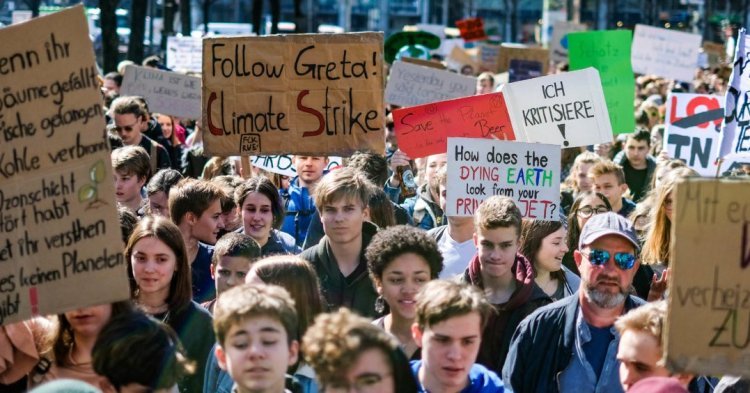Climate: a factor of political disruption
In Germany, the Greens are in high spirits. For the first time in their history, the party ‘Bündnis 90/Die Grünen’ (Alliance 90/The Greens) came second in an election at national level. With 20.5% of the votes — almost twice as many as in the 2014 EU elections — it overtook the the SPD (the workers’ party in power alongside Angela Merkel’s CDU party) which had only 15.8% of the votes, twice as few as in 2014. The Christian Democrats, the main party in German government, managed to stay in the lead, but barely, with 22.6% of the vote. The reason for this this disruption: voters’ unprecedented level of concern for climate change. The subject, for a long time absent from political debate, has become a real source of worry for many Germans — coming before social security, peace and migration, according to an Infratest Dimap poll featured in the newspaper Handelsblatt.
Engaging in the environment in Germany: a recent and historic dynamic
Thus, the Green’s success in Germany is part of a momentum rallying to protect the environment and fight against climate change, that is growing even stronger. The huge youth demonstrations “Fridays for Future” — boycotting lessons has been going on for months all around the world in order to protest political apathy towards the danger of climate change — have brought the topic to everyone’s attention. A topic that the Greens seem to be the best representative of in Germany.
The ‘Bündnis 90/Die Grünen’ is actually the result of a long history of mobilisation stemming from all areas of society: radical opposition movements, student protests, and rallying for the environment, peace and women’s rights since the 1960’s and 70’s that in 1980 came together to form a political party. After the reunification of East and West Germany in 1990, the Greens of the West and its counterpart Bündnis 90 in the East joined together in 1993. An opposition party from its beginning, today the Greens seem to be a real alternative to the established parties — especially for young voters.
The Green’s success: a sign of intergenerational divide…
Indeed, the Greens owe their historic success in the European Elections to young people: among the under-30s the party received 33% of the vote, compared to 9% of over-70s. The divide between generations is clear. While almost half of retired voters supported the CDU, that is currently in government, the young generation expressed their frustration with traditional, established parties. This feeling of not being heard by those in power was expressed in a sensational video by Rezo, a young activist on Youtube, that was uploaded a few days before the European elections. With the contentious title “The destruction of the CDU”, Rezo criticised the approach of the two parties that have been in power for decades, warning of the major risks of political disinterest towards climate.
In his video, Rezo then openly called for young people to not vote for the CDU, the SPD and the extreme right-wing party AfD (Alternative for Germany) which completely denies human responsibility for climate change. Within a few days the video had several million views and sparked considerable debate in Germany. Its real influence in the election cannot be measured, nevertheless, the new head of the CDU, Annegret Kramp-Karrenbauer (nicknamed AKK) reacted by criticising youtubers and proposed regulating the site ahead of elections. For many young people this reaction only intensified their feeling that the traditional parties do not respect them and are not able to adapt to young peoples’ reality, who inform and express themselves through digital mediums.
…and geographic and structural divides
The intergenerational division — that the Greens’ success in the elections has well illustrated — is however not the only thing that divides Germany. The Greens’ good result happened against a backdrop of a division between rural and urban areas as well as the old ‘West’ and ‘East’ of the country. The party received its best scores in Germany’s large towns and cities - a sign of young people, academics and the well-off, places where a healthy lifestyle and interest in sustainable development are in vogue. With two exceptions: Leipzig and Dresden, the only big cities in the east of the country.
Almost 30 years after the reunification of Germany, the East-West division is still relevant today. Performing less well economically, the ‘East’ is also a stronghold of the German extreme-right. In two eastern regions, the party took the lead with up to 25% of the vote. This can be explained by the differing concerns of each area: in the west there is a strong interest in climate issues as well as more open-mindedness on the topic of immigration — both represented by a green, liberal and pro-Europe party. In the east, that has remained more rural and industrial — 7 out of 10 coal mining regions are found in the eastern regions — AfD attracts climate change sceptics as well as opponents of the EU and liberal asylum policies.
The ‘green wave’ - a German phenomenon?
With 21 MEPs in the new European parliament, the German Greens will make up almost a third of the EFA group (European Free Alliance) which won 69 seats in the European elections. While an excellent result for the German party, the ‘green wave’ is still a relatively modest phenomenon on the European level. It was mostly in the north and west member countries that Greens gained votes. In the south and east however, they proved to be much less important. According to Milan Nic, researcher at the Robert Bosch Centre for Eastern and Central Europe, Russia and Central Asia, in an article in the German newspaper Jetzt, this contrast stems from the structural difference between the east and west of the continent.
In the east, being more industrial, less urbanised and more rural than the rest of Europe throughout its history, topics like the environment and climate have taken a back seat compared to other issues. Overcoming the major political and economic upheavals following the collapse of the USSR took priority over developing political trends like rallying for the climate - which the German Greens, as we have seen, have more than half a century of experience in. Despite these contrasts, green themes are far from absent in the wider European political landscape. Even if they are not represented everywhere by a strong green party, they have become a major issue for those acting on a European level, independent of political affiliation.
The Greens: an alternative to the current government?
In Germany, the Greens’ success shows much more than concern for the climate, a theme taken up by all parties except the extreme-right. This incredible success particularly illustrates the dissatisfaction of a growing part of the population with the mainstream parties usually in power. Thus, the Greens’ success brings with it a crisis for the SPD that could well turn into a governmental crisis. The centre-left party saw two crushing defeats on the 26th May - in the European elections where it was overtaken by the Greens, and in the local elections in the Bremen region, historically an SPD stronghold, where it lost to the CDU.
These are two blows for the party whose leader, Andrea Nahles, announced her resignation a week after the voting amidst disorder and general disapproval. With this resignation, the great coalition governing Germany rather grudgingly since 2017 has lost one of its main supporters from the SPD. For many observers, the coalition risks fracturing before it’s even halfway through its term in office — casting doubt on what will happen next with the current government. Brought to the forefront by the European elections, the Greens must now show they have the ability necessary to put themselves forward as a real alternative for government in Germany.




Follow the comments: |
|
